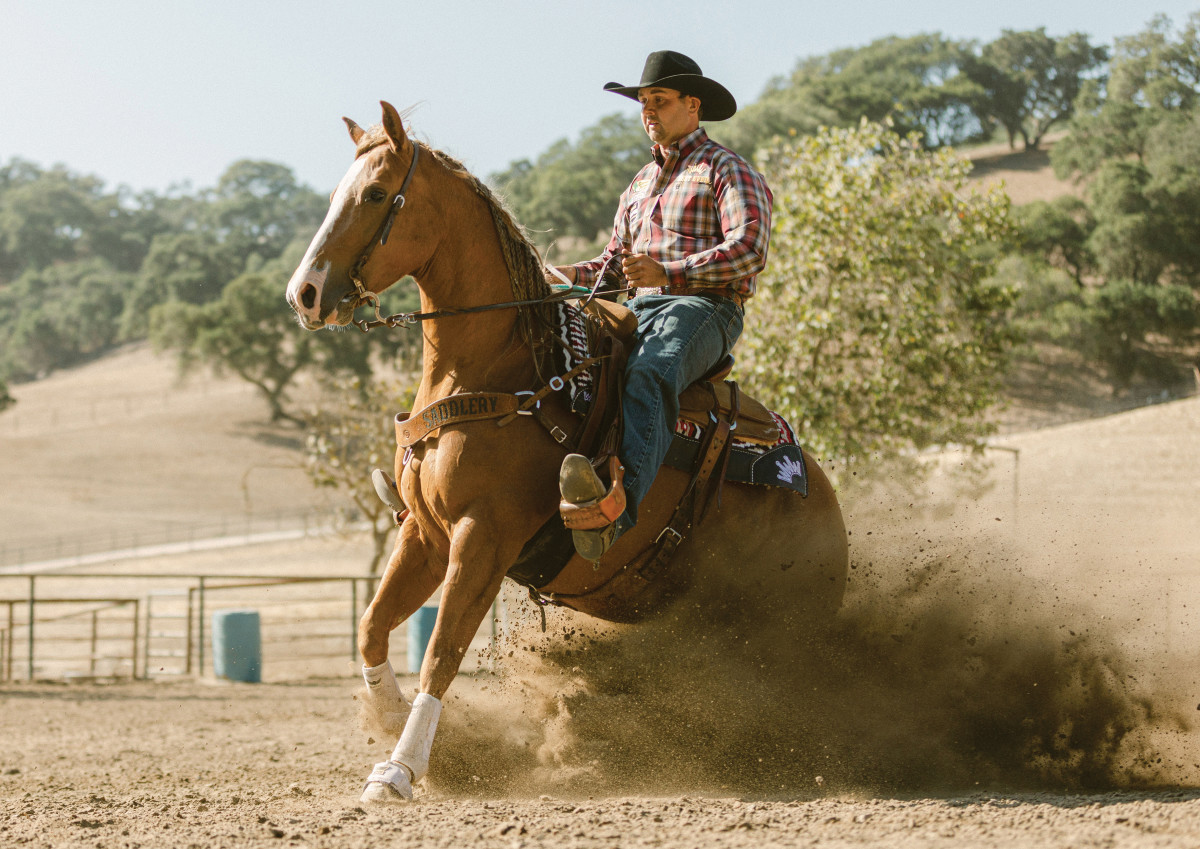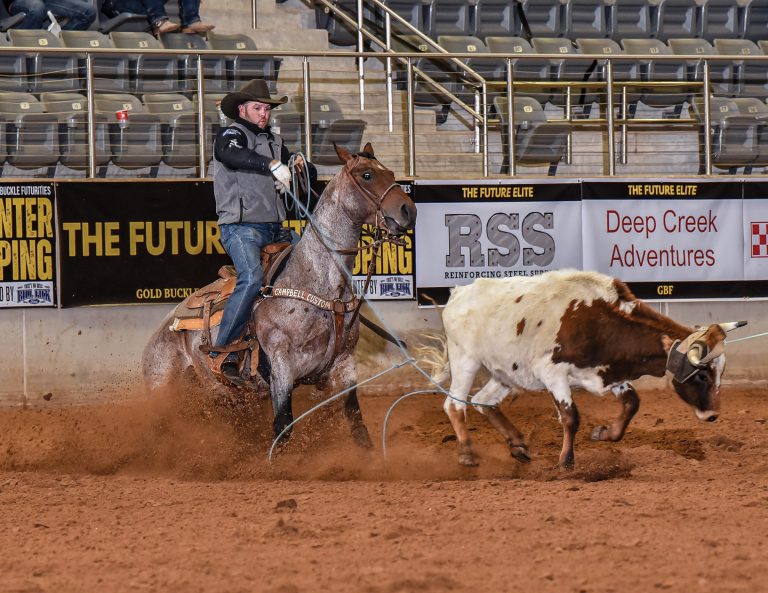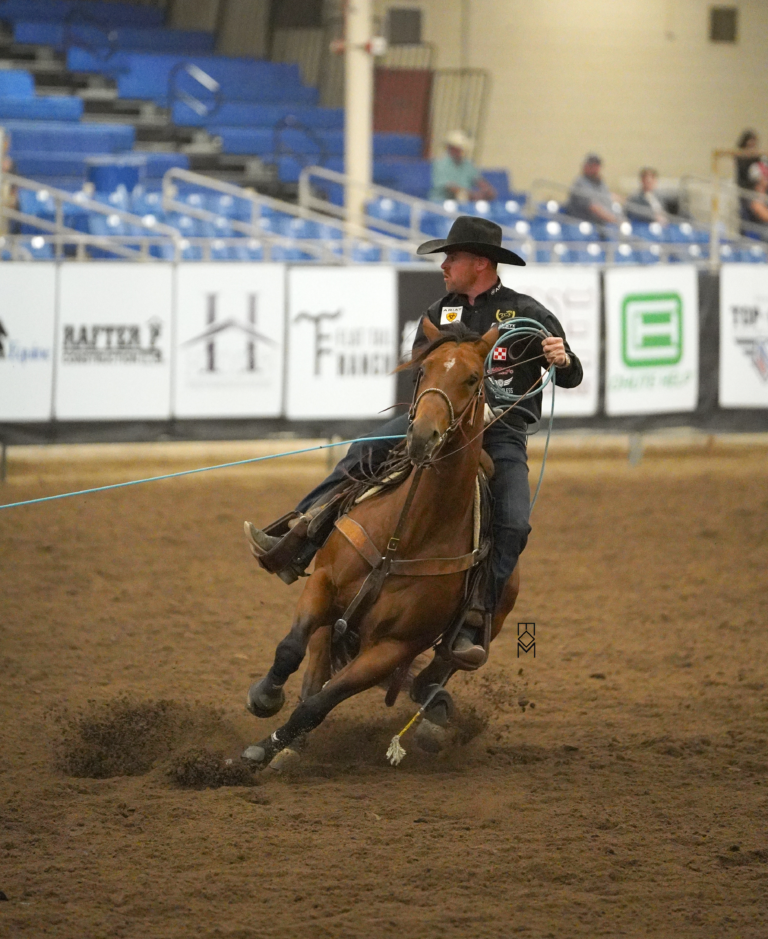[As seen in the March 2022 issue of The Team Roping Journal]
It’s no secret that roping futurities are exploding in entries and purses. But long before Trevor Brazile brought his rodeo cowboy fame to the tiny struggle-bus niche of rope horse training, the futurity spotlight was on a hand named Andy Holcomb from California.
Hailing from just north of Salinas, 35-year-old Holcomb has been quietly putting three to five young horses into futurity short rounds at both ends. Three years ago, Holcomb won the ARHFA World Championship in Open Heading and $20,000 aboard an eye-catching, grey 6-year-old named Blue Berry Please (plus claimed fourth on a 5-year-old stallion named Trap This Cat for another $10,000). “Blue Berry” was a horse the owner had sent him to sell.
That was typical. For decades, rope horse trainers have had to serve as part horse-trader, part colt-starter and part jackpot horse fixer-upper, while spending years making their own horses to sell. Now there’s a new way to fill their pockets.
At the October 2021 ARHFA World Championship in Fort Worth, Holcomb’s horses racked up $36,000. He placed on three head horses and two heel horses, plus, he brought the only horse—Walkin The Dog—that made the finals at both ends. Last August at the Royal Crown Futurity in Rock Springs, Wyoming, he cashed paychecks worth $35,048 when he won the Open heading on Walkin The Dog, placed on both ends aboard SJR Diamond Go Time, and placed in the heeling aboard Fine Vintage Cash. He earned money on those same horses and more at last June’s ARHFA RedBud Spectacular in Oklahoma, after cleaning up at the ARHFA’s 2021 Arizona Sun Circuit Futurity to the tune of $22,336.
Listen: Understanding the Royal Crown on “The Score”
With a background in working cow horses and a current Global 7.5/8.5 handicap, Holcomb could choose any number of competitive goals, but he’s focused on one: to earn $1 million at roping futurities.
California Ranch-Raised
Growing up, Holcomb ranch-roped, but never backed a horse into a box. He’d watched his longtime buddy Justin Wright show reined cow horses, and was just a kid when his parents hired Les Oswald to give him lessons.
“I’d go stay with Les during every summer break and Christmas break and any other time I could,” recalled Holcomb, who eventually went to work full time for Oswald. “I got where I could catch and turn him steers, and it was all about scoring well and giving smooth handles. A lot of repetitions is what helped me. I was not having to fight speed in the beginning.”
Oswald, who campaigns winning snaffle-bit and reined cow horses, as well as premium head and heel horses, said his entire program is about catching every single steer.
“A horse cannot be trained when you’re missing,” said Oswald, based in Oakdale. “You have to catch. If you run 10, you’d better catch 10. I had a rule back then, and still do today: If you miss three in a row, you will put it on in the chute until I get off that horse.”
Oswald’s program is based on using your horse—score well, rope sharp and handle the cow so your heeler can rope as fast as possible. That’s what he preaches to his son, Layton, and to his help, and it’s what helped make Holcomb one of the winningest futurity horsemen out there.
No Rodeo No Problem
Holcomb ropes so sharp, in fact, it’s a wonder he never caught the rodeo bug. After all, he heeled a few down for Luke Brown to split $25,976 at the Capitalist a few years ago. Further back than that, he split $26,000 in the #15 at the Finale in Las Vegas turning steers for Craig Branham. But his mentor had a little influence there, too.
“I watched Les barely miss the NFR in the mid-1990s,” Holcomb said. “He came home with a broke-down truck, crippled horse, bald tires on his trailer and no money in his bank account. That didn’t sound good to me.”
Not to say Holcomb hasn’t placed in a round at Salinas and made the California Circuit Finals Rodeo.
“I almost use the circuit rodeos as a training tool for myself,” he said. “The futurities are getting more and more competitive just roping-wise. Headers have to ride wider and be more aggressive, and they’re heeling them faster and cleaner. I think of rodeoing as a tool to keep me sharper in that sense.”

Confidence and Consistency
Holcomb likes colts with “good structure, explosive feet and presence,” he told his sponsor, Best Ever Pads, for a recent blog post. That presence helps a young horse get noticed by judges even away from the run. And if his horses are noticeably confident, it’s likely thanks to his early methods. Holcomb does a ton of lead-steering on green colts.
Holcomb’s business in Aromas, California, generally slows down to about five horses in the dead of winter. But because of the Royal Crown’s first-ever February futurity in Arizona this year, he still had 20 on his roster in January, including 3-year-olds getting prepared for next year. He has great help in his wife, Fallon Avery, and a few other part-timers and local teenagers who come to rope.
Watch: Colt-Starting Playlist
“When I’m tracking lead steers, I like to go a little faster,” he said. “Tracking faster cattle teaches horses to be okay with speed before you add the box into the equation. My horses still get slow work, but I want them comfortable going fast.”
It’s a way to remove the pressure of the box but add the unpredictability of cattle. It’s something that always worked for Oswald, who says he learned it roping jerseys in the pasture with Monty Joe Petska back in the day.
“When horses learn to handle speed before they ever come out of a box, everything goes so much smoother,” Holcomb said. “I’ve been bucked off a lot; most of the time because speed scares a horse.”
One thing different about Holcomb’s program—compared to, say, Brazile’s—is that Holcomb does fence work on his green colts, too. He’ll take cows down the fence and turn them back and circle them in the middle of the pen like you see at big NRCHA shows. He likes the way it teaches them to change speed, stop and turn around while following a cow.
“A horse can run fast but still read the steer and listen to me at the same time,” he explained. “I don’t want a horse to completely look at the steer and not pay attention to me, or vice versa.”
A Better Horse
By the time Holcomb’s colts enter a box, they’re completely prepared because he’s done so much on lead steers with a breakaway rope. He can work on their move, their face and all the motions of a run. At home, Holcomb’s boxes are set up so he can move them back some 25 feet. The unique design allows him to walk-start a colt, or begin walking and continue walking as he nods for the steer.
“It gives a horse plenty of space so it’s not just, ‘take one step and go,’” he said. “A horse can take five or six steps before the gate opens and then cruise to the cow.”
Holcomb’s horses are locked and loaded when he arrives at a show but, from his perspective, the key to getting so many into short rounds is minimizing mistakes.
“Sometimes a leg will still bring a head horse back to the finals, but you can’t have a barrier, and you can’t be late and bounce one off the back end, either,” he said. “It always helps to enter the horses that are most consistent. My program isn’t limited to only horses I’m training, though they’re my priority. I show for other people, too.”
Watch: What Makes a Good Prospect
The advantage of showing his own colts means he knows them better. Knows where he can count on them and where to help them. Like most rope horse trainers, what he loves about futurities is they’re not just timed—the horses are judged.
“Headers aren’t exposing a horse by reaching or ducking, and heelers aren’t pulling back and getting them shaking their head,” he said. “It’s a competitive way to make a better horse, these futurities.”
Truly, there aren’t many 6-year-olds better than Dreams To Watch, aka “Wyatt,” the stunning dark buckskin Holcomb showed last fall into the top 10 at Fort Worth, then sold to NFR average champion header Cody Snow.
The spotlight just keeps getting brighter.











